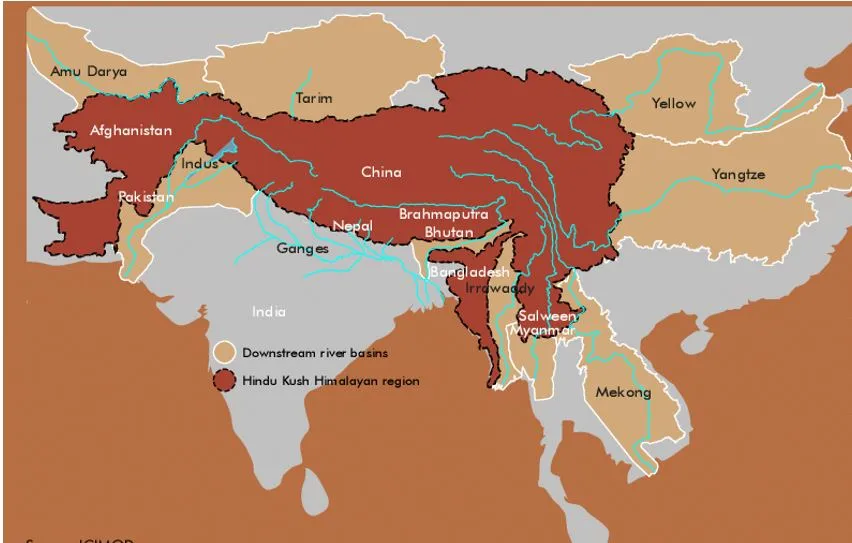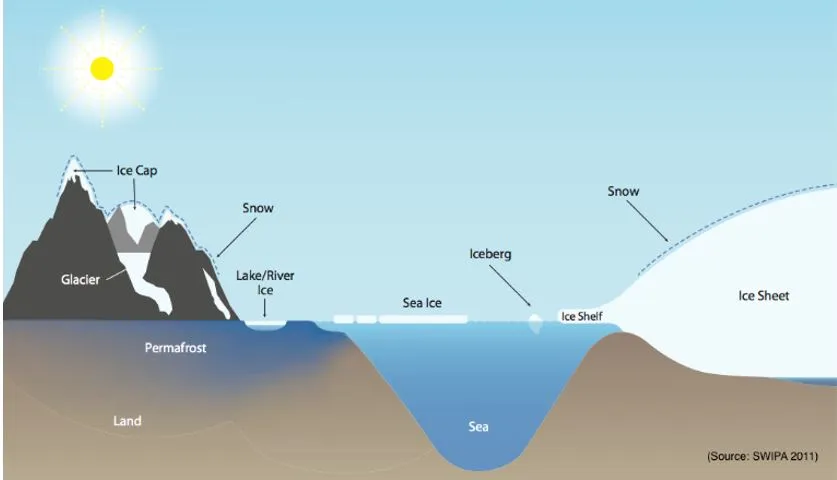

22nd April 2025 (9 Topics)
Mains Issues
Context
The International Centre for Integrated Mountain Development (ICIMOD) reported that seasonal snowfall in the Hindu Kush-Himalayan (HKH) region is 23.6% below normal, the lowest in 23 years. This threatens water security for nearly two billion people dependent on snowmelt for freshwater.
Key Findings of the ICIMOD Report
- Snow persistence has dropped 6% below normal, continuing a three-year declining trend.
- Delayed and reduced snowfall observed across winter months (especially late start in January).
- Drought warnings issued across several countries.
- Snow loss in Mekong and Salween basins reached around 50%, affecting China and Myanmar.
- Impacts include:
- Reduced river flows
- Increased reliance on groundwater
- Greater risk of agricultural droughts and food insecurity
- Countries Affected: Afghanistan, Bangladesh, Bhutan, China, India, Myanmar, Nepal, and Pakistan
- These nations are members of ICIMOD and depend heavily on glacial and snowmelt-fed rivers.
- The Hindu Kush-Himalayan (HKH) region spans Afghanistan to Myanmar, encompassing 12 major river basins including the Ganga, Brahmaputra, Indus, Salween, and Mekong.
- It is home to the third-largest ice and snow reserves in the world, after the Arctic and Antarctica.
- The region is often referred to as the "Third Pole" due to its vast cryospheric extent.
- Major rivers:It is the source of ten large Asian river systems – the Amu Darya, Indus, Ganges, Brahmaputra (Yarlungtsanpo), Irrawaddy, Salween (Nu), Mekong (Lancang), Yangtse (Jinsha), Yellow River (Huanghe), and Tarim (Dayan)
- India’s area: Entire territory of 11 mountain states (Assam, Uttarakhand, Himachal Pradesh, Manipur, Jammu & Kashmir (Indian administered area), Meghalaya, Mizoram, Nagaland, Sikkim, Tripura, Arunachal Pradesh), & Darjeeling district of West Bengal state.

Implications
- Water Security: Melting snow contributes significantly to pre-monsoon river flows. Lower snowfall disrupts agriculture, hydropower, and drinking water supply in Himalayan foothill regions. Greater reliance on groundwater raises concerns of aquifer depletion.
- Food Security: Upcoming harvests at risk, especially rabi crops like wheat. Drought and water stress may lead to crop failures, impacting food supply and rural livelihoods.
- Climate Change: Declining snowfall reflects climate-induced anomalies. ICIMOD warns of "locked-in carbon emissions" making such anomalies recurrent.
Required Measures
- Regional Cooperation: Rivers in the HKH region are transboundary, needing joint water governance mechanisms. ICIMOD calls for:
- Improved water management
- Drought preparedness
- Early warning systems
- Regional collaboration
|
Fact-Box Cryosphere:
|


Mains Issues
Context
India is likely to impose a 12% temporary safeguard duty on imports of stainless steel to counter the surge of cheap imports, mainly from China, South Korea, and Japan. The move comes in response to concerns over injury to the domestic steel industry, especially smaller producers.
India’s Position in Global Steel Market:
- Steel is considered a strategic and infrastructure-critical sector. Ensuring its health is vital for long-term economic growth, defence needs, and energy infrastructure
- India is the second-largest producer of crude steel globally.
- India has registered a 38 per cent surge in imports of finished steelto 8.319 million tonnes (MnT) over 6.022 MnT imported during the preceding 2022-23 fiscal. The surge in predatory imports from China is a big threat to the Atmanirbharta in steel.
- Finished steelincludes non-alloyed offerings, alloyed ones and stainless steel. Finished steel imports reached a 9-year high at 5 million metric tons.
- Countries Dominating Imports: China, South Korea, and Japan account for 78% of India’s total finished steel imports.
- Domestic Industry Concerns: Indian steelmakers have urged the government to take corrective steps as cheaper imports have forced smaller domestic mills to cut production and consider job losses.
- Protect Domestic Industry: Prevent long-term harm to domestic producers due to underpriced foreign imports.
- Reduce Trade Imbalance: Control the increasing dependency on imported finished steel.
- Support Employment: Avoid job losses in small and medium steel enterprises (SMEs).
- Trade protectionism: Many countries are taking protective trade measures against Chinese steel exports, which are accused of dumping — selling below market price to gain market share. The move aligns India with global trends of trade protectionism, particularly in strategic sectors.
|
Positive: |
Negative: |
|
|
|
PYQ Q1. Account for the present location of iron and steel industries away from the source of raw material, by giving examples. (2020) Q2. Account for the change in the spatial pattern of the Iron and Steel industry in the world. (2014) |


Prelims Articles
Context
In a landmark judgement, in State of Tamil Nadu v The Governor of Tamil Nadu, the Supreme Court invoked Article 142 of the Constitution to grant deemed assent to ten bills that had been pending with the Governor without action, reigniting the debate over the scope and limits of judicial powers under Article 142.
What is Article 142?
- Article 142(1) empowers the Supreme Court to “pass such decree or make such order as is necessary for doing complete justice in any cause or matter pending before it.”
- It is often considered a residual power, to be used when no other provision in law provides an adequate remedy.
- The power is discretionary and not meant to override or replace existing laws, but rather to supplement them in exceptional circumstances.
Precedents Supporting Article 142
Cases Where Article 142 Was Refused
|


Prelims Articles
Context
In a significant step towards enhancing India’s maritime infrastructure and cruise tourism potential, the Union Minister of Ports, Shipping and Waterways flagged off cruise operations from the newly inaugurated Mumbai International Cruise Terminal (MICT) at Ballard Pier. This development marks a major milestone under the Centre’s ambitious Cruise Bharat Mission.
Key Features of MICT
- Mumbai International Cruise Terminal (MICT) is capable of handling one million passengers annually
- It is equipped to accommodate five cruise ships simultaneously
- It spans 4.15 lakh sq ft, featuring 72 immigration counters
- It is built with modern architectural elements reflecting Mumbai’s coastal heritage, including a wavy ceiling, rose-gold accents, and wave-shaped seating
- It is designed to meet international cruise standards, promoting ease of movement and better security.
Cruise Bharat Mission
 |


Prelims Articles
Context
ISRO successfully conducted the second docking experiment of the SPADEX mission, involving two satellites — SDX-01 and SDX-02. This time, the docking was performed fully autonomously from a distance of 15 metres. Following this, ISRO also demonstrated inter-satellite power transfer, marking a significant milestone in India's space technology capabilities.
What is ‘Docking’ in Space?
- Docking refers to the process where two spacecraft physically connect with each other while in orbit.
- It involves aligning and bringing together one spacecraft with another, typically to transfer crew, materials, or resources like power and fuel.
- Docking is critical for:
- Space station operations
- Satellite servicing and refuelling
- Multi-spacecraft missions
- Human spaceflight support systems
- It can be manual, semi-autonomous, or fully autonomous, depending on the mission design and technology.
Key-Details of the Second Docking Experiment
- Autonomous Docking: The second docking was conducted without manual intervention, unlike the first attempt in 2023 where a manual hold was placed at 3 meters.
- This time, docking occurred completely autonomously from 15 metres to contact.
- Prior to this attempt, extensive ground simulations and in-orbit trials were conducted using insights from the first experiment.
- Power Transfer Demonstration: Power was transferred from SDX-02 to SDX-01 and vice versa. The power supported the operation of a heater element in the receiving satellite.
Fact-Box (SPADEX Mission)
|


Prelims Articles
Context
Astronomers have discovered a unique galaxy, named the Bullseye Galaxy (LEDA 1313424), that contains nine concentric rings — more than any previously known ring galaxy. This rare celestial structure was observed using the Hubble Space Telescope and the W.M. Keck Observatory in Hawaii. Researchers believe this galaxy may also offer valuable insights into the formation of giant low surface brightness (GLSB) galaxies, which are crucial to understanding dark matter in the universe.
What is the Bullseye Galaxy?
- LEDA 1313424, or the Bullseye Galaxy, is an unusually large galaxy around 250,000 light-years in diameter — about 5 times the size of the Milky Way.
- It contains nine ring-like structures — an exceptional feature, since most known ring galaxies have only two or three rings.
- This makes it a rare cosmic object, captured during a brief stage of its evolution.
- How Did the Rings Form: A Galactic Collision
- About 50 million years ago, a blue dwarf galaxy passed directly through the centre of the Bullseye Galaxy.
- This rare head-on collision triggered gravitational ripples in the gas of the Bullseye Galaxy.
- These ripples caused gas compression and new star formation, which created the distinct concentric rings seen today.
- Ring Formation Mechanism: Although the stars' orbits remained unaffected, the gas and star clusters realigned, forming wave-like patterns that resulted in ring formation. The presence of a gas trail between the two galaxies, even though they are 130,000 light-years apart, supports the collision theory.
Fact-Box (LSB and GLSB Galaxies)Low Surface Brightness (LSB) Galaxies:
Giant Low Surface Brightness (GLSB) galaxy
|


Editorials
Context
India and China mark 75 years of diplomatic relations in 2025 amidst complex geopolitical tensions and strategic rivalry. The milestone highlights the need for a pragmatic, long-term approach in managing a multifaceted bilateral relationship shaped by historical conflicts, border tensions, and economic interdependence.
Strategic Landscape and Military Dimensions
- Evolving Relationship Context: China remains the most consequential external factor shaping India’s foreign policy—from border deployment to trade and global alignments. The relationship has evolved from idealistic Pan-Asianism to strategic distrust and competition.
- Border Infrastructure and Militarisation: The Galwan clash in 2020 altered India’s China posture. The Line of Actual Control (LAC) remains tense, with over 60,000 Indian troops permanently deployed in Eastern Ladakh, and infrastructure being rapidly fortified on both sides.
- Military Readiness as Policy Pillar: India’s China policy includes deterrence without provocation. Military preparedness acts as a vital guardrail in preventing escalation amid continuing lack of border resolution.
Economic Interdependence and Competitive Engagement
- Trade Paradox: Despite growing tensions, China remains one of India’s largest trading partners. The trade deficit nearedUSD100 billion in 2024–25, reflecting a paradox of border deterrence versus market dependency.
- Competitive Coexistence Framework: India balances regional competition with limited engagement via multilateral forums like BRICS, SCO, and QUAD. This approach promotes strategic autonomy without decoupling entirely from China.
- Regional Strategic Contest: China’s strategic footprint across South Asia—via projects like Hambantota Port, Pokhara Airport, and Maldives loans—has challenged India’s influence. India counters this through connectivity, aid, and rapid crisis response, aiming for sustained regional trust-building.
Diplomatic Signalling, Narrative Control, and Way Forward
- Strategic Diplomacy and Recalibration: Recent comments by PM Modi highlighting ancient civilisational synergy and “healthy competition” on global platforms suggest a controlled narrative shift signalling openness to limited cooperation while safeguarding core interests.
- Signs of Tactical Thaw: Verification patrols resumed in 2025; China agreed to early expert-level talks on hydrological data and discussions to restart Kailash Mansarovar Yatra. These are signs of a diplomatic thaw, not resolution.
- Future Policy Architecture: India's long-term China policy must be rooted in four pillars:
- Military Readiness
- Economic Diversification
- Diplomatic Engagement
- Narrative Control
Practice Question
Q. Discuss the concept of 'Competitive Coexistence' in the context of India-China relations. Evaluate how India can maintain strategic autonomy while managing security challenges and economic dependencies with China.


Editorials
Context
The Supreme Court's recent verdict in State of Tamil Nadu v. Governor of Tamil Nadu (2025) reaffirmed the constitutional limits and responsibilities of the President and Governors in India's parliamentary system, emphasizing adherence to ministerial advice and timely exercise of constitutional duties.
Parliamentary System: Constitutional Design and Legacy
- Ceremonial Position Defined by Ambedkar: B.R. Ambedkar clarified that the President in India is equivalent to the British Crown — a symbolic head, not an executive authority. This distinction is foundational to India’s adoption of parliamentary democracy over the presidential model.
- Binding Nature of Ministerial Advice: Articles 74 and 163 explicitly mandate that both the President and Governor act on the aid and advice of the Council of Ministers. They are not empowered to act independently, reaffirming collective responsibility as a core tenet.
- Rejection of American Presidentialism: The Constituent Assembly rejected proposals to equate the President with the chief executive, as seen in the U.S. model. Instead, the Constitution embedded cabinet responsibility to ensure accountability to the legislature.
Judicial Affirmation of Constitutional Norms
- Shamsher Singh Case (1974): The Supreme Court clarified that the President and Governors are formal heads, and must act on ministerial advice. The judgment reaffirmed the ceremonial nature of their roles within a constitutional framework.
- Nabam Rebia Case (2016): Reiterated that Governors must respect the majority will in the legislature, and any deviation from constitutional roles can be judicially reviewed.
- State of Tamil Nadu v. Governor of Tamil Nadu (2025): The apex court directed the timely assent to bills and decisions, asserting that delays or refusals undermine democratic will and invite judicial scrutiny under writ jurisdiction.
Constitutional Morality and Institutional Conduct
- Oath-Bound Obligations (Articles 60 & 159): Presidents and Governors pledge to preserve, protect, and defend the Constitution, and to serve the people. Violations of these oaths dilute constitutional accountability.
- Judicial Oversight on Constitutional Duty: When the executive head fails to perform a constitutionally mandated duty, courts can compel action. Powers come with accountability and timelines, not discretion.
- Ethical Concerns in Gubernatorial Conduct: While the President has generally upheld decorum, some Governors have acted in defiance of constitutional norms, politicizing their roles, which the judiciary has rightly sought to correct.
Practice Question
Q. The constitutional framework of India mandates the President and Governors to function as nominal heads, bound by ministerial advice. Critically examine how judicial interventions have reinforced this principle, especially in light of the 2025 Supreme Court judgment.

Editorials
Context
A recent article by Balakrishna Pisupati, Country Head of UNEP India, highlights the urgent need for India to recalibrate its innovation ecosystem by investing in grassroots creativity. As the global creative economy grows rapidly, India must bridge the gap between raw creativity and scalable innovation to harness economic and social value, especially at the grassroots level.
The Global and Indian Creative Economy: Emerging Trends
- Global Creative Economy Expansion: According to UNCTAD’s Creative Economy Outlook 2024, global creative services exports hit USD 4 trillion in 2022, with creative goods reachingUSD713 billion, together supporting 50 million jobs worldwide.
- India’s Contribution: India’s creative economy exports stood at USD 121 billion in 2019, led by creative services (USD 100 billion). As of 2024, the industry is valued at USD 30 billion, employing around 8% of the workforce, with a 20% export growth recorded in the past year.
- Sectoral Leaders: The top three contributors to the global creative economy are software services (41.3%), R&D (30.7%), and advertising, market research & architecture (15.5%).
Creativity vs Innovation: Addressing the Gap in India
- Creativity Types and Local Innovation: Creativity can be deliberate or spontaneous, and either cognitive or emotional. Grassroots innovations in India often fall into deliberate-cognitive or spontaneous-cognitive types but remain underdeveloped due to lack of systemic support.
- Innovation Requires Institutional Support: While creativity is often individual-based, innovation demands institutional investment. India shows rich creativity, but many ideas (like the mitti cool fridge or pedal washing machine) lack scale or protection.
- Role of Institutions and Networks: Organizations like GIAN (Grassroot Innovations Augmentation Network) have recognized and promoted hundreds of grassroots innovations, but further scaling requires formal IPR protection and targeted capital investments.
Rethinking Investment: Scaling Creativity into Innovation
- Creative Ecosystem Investment Gaps: Despite climate tech attracting USD85 billion in 2023, investments in grassroots creativity are negligible. Small redirection of this capital could significantly enhance local climate resilience and innovation.
- Policy Innovation – One District One Innovation: Replicating the successful One District One Product (ODOP) scheme, the government should launch a One District One Innovation (ODOI) programme to stimulate decentralized creativity and job creation.
- Protection and Commercialization: India’s IPR framework must evolve to protect informal innovations and indigenous creativity. Only through legal, financial, and infrastructural support can creative ideas become commercially viable innovations.
Practice Question:
Q. “India has an abundance of grassroots creativity but lacks the systemic ability to translate this into scalable innovation.” Critically examine this statement in the context of India’s creative economy. Discuss how institutional reforms, targeted investments, and intellectual property policies can bridge this gap.





